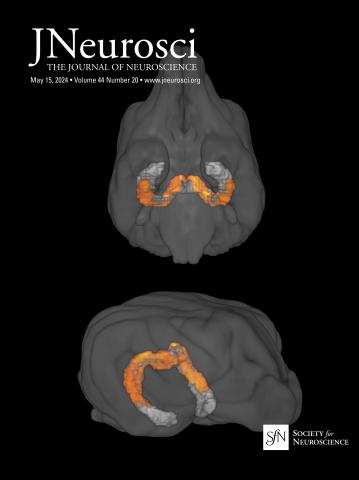Synchronous rhythmic activity in area V4 can impair shape detection and neuronal reliability.
IF 4.4
2区 医学
Q1 NEUROSCIENCES
引用次数: 0
Abstract
Rhythms at a population level are a defining characteristic of both normal and pathological cortical activity, but it is unclear howsuch rhythms interactwith activity of specific neurons to impact task performance on a trial-by-trial basis. We address this by employing a challenging visual detection task in which male rhesus macaques must signal the presentation of a shape embedded in a noisy background. We analyzed the rhythmic activity in the local field potential (LFP) and single neuron activity in area V4, a brain area strongly implicated in shape perception, prior to such presentations and focused on two different frequency ranges: alpha/beta (10-30 Hz), in which coherence was particularly strong and spatially extensive, and gamma (50-70 Hz), which has traditionally been strongly associated with single unit activity. We find that within sessions there were periods of time during which successful detection was associated with the absence of rhythmic activity prior to shape presentation in either frequency range. During these periods, rhythmic activity in both frequency bands could predict whether the shape would be detected by the animal at the time of, as well as before, shape presentation on a trial-to-trial basis with high accuracy. Importantly, for both frequency ranges, the individual neurons carrying the most relevant information with regard to the task had the weakest coupling to the LFP rhythms. These results are consistent with spatially-distributed rhythmic activity acting as a source of decision noise in the context of rapid visual detection by reducing the moment-to-moment reliability of task-relevant information carried by individual neurons.Significance Statement Although rhythmic activity in the brain has been studied for over 100 years, its relevance to information processing remains unresolved. In this study we show for the first time that, in the context of a challenging visual detection task, rhythmic activity in local populations of neurons prior to appearance of the visual stimulus can predict mistakes on a trial-by-trial basis. Furthermore, this activity is linked to task-relevant signals at a neuronal level because the individual neurons with the weakest coupling to these rhythms are the most reliable.V4区的同步节律性活动会损害形状检测和神经元的可靠性。
群体水平上的节律是正常和病理皮层活动的一个决定性特征,但目前尚不清楚这种节律如何与特定神经元的活动相互作用,从而在一个又一个试验的基础上影响任务表现。我们通过一项具有挑战性的视觉检测任务来解决这个问题,在这项任务中,雄性恒河猴必须在嘈杂的背景中发出嵌入形状的信号。在这些展示之前,我们分析了局部场电位(LFP)的节律性活动和V4区域(与形状感知密切相关的大脑区域)的单个神经元活动,并重点分析了两个不同的频率范围:α / β (10-30 Hz),其中一致性特别强且空间广泛,以及伽马(50-70 Hz),传统上与单个单元活动密切相关。我们发现,在会话中有一段时间,在这段时间内,成功的检测与形状呈现之前在任何频率范围内缺乏节奏活动有关。在这些时期,两个频段的节律性活动可以预测动物在形状呈现时和之前是否会检测到形状,并且准确度很高。重要的是,在这两个频率范围内,携带与任务最相关信息的单个神经元与LFP节律的耦合最弱。这些结果与空间分布的节律性活动在快速视觉检测中通过降低单个神经元携带的任务相关信息的即时可靠性而成为决策噪声的来源一致。尽管大脑中的节律性活动已经被研究了100多年,但其与信息处理的相关性仍未得到解决。在这项研究中,我们首次表明,在具有挑战性的视觉检测任务的背景下,在视觉刺激出现之前,局部神经元群体的节律性活动可以在逐个试验的基础上预测错误。此外,这种活动与神经元水平上的任务相关信号有关,因为与这些节律耦合最弱的单个神经元是最可靠的。
本文章由计算机程序翻译,如有差异,请以英文原文为准。
求助全文
约1分钟内获得全文
求助全文
来源期刊

Journal of Neuroscience
医学-神经科学
CiteScore
9.30
自引率
3.80%
发文量
1164
审稿时长
12 months
期刊介绍:
JNeurosci (ISSN 0270-6474) is an official journal of the Society for Neuroscience. It is published weekly by the Society, fifty weeks a year, one volume a year. JNeurosci publishes papers on a broad range of topics of general interest to those working on the nervous system. Authors now have an Open Choice option for their published articles
 求助内容:
求助内容: 应助结果提醒方式:
应助结果提醒方式:


